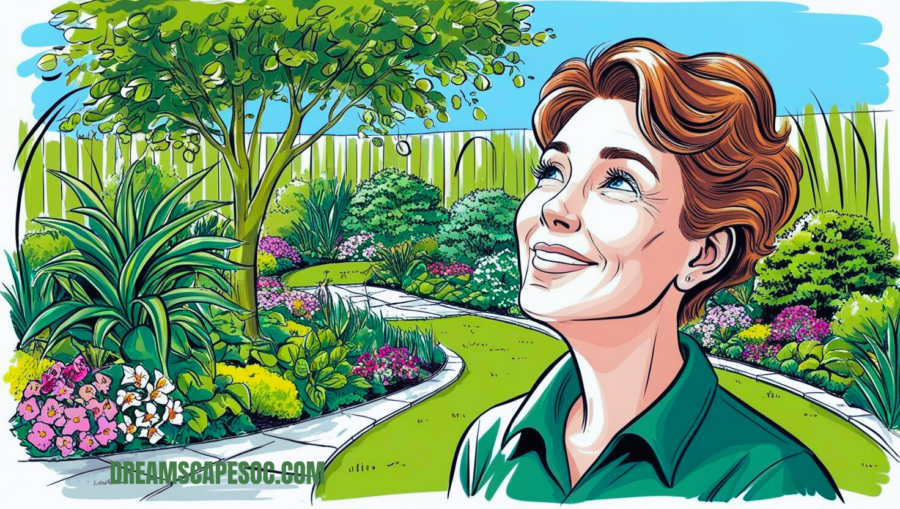Transform Your Front Yard: Simple Landscaping Tips to Boost Curb Appeal
Let’s explore some fun, creative, easy-to-implement landscaping tips to turn your home into a head-turner. Whether you’re interested in low maintenance or creating a lush, vibrant oasis with sustainable landscaping practices, I’ve got you covered.
Click here for instant access to Landscaping Design Ideas
Plan The Transformation of Your Yard
Let’s plan our course of action before you begin digging. A carefully considered plan guarantees that everything functions as a whole. Evaluate your space first. Take measurements of your front yard and note any existing features, such as walkways and trees. You can better grasp the project’s scope and prevent unpleasant surprises later on with the help of this preliminary evaluation. Specify your objectives: For privacy, curb appeal, or a paradise of low maintenance? You can stay focused and make wise decisions if you have clear goals. Sketch it out. Draft a rough layout with plant placements, hardscape elements, and focal points. A visual plan will help you see the big picture and make adjustments before you start working. Finally, pick the style that complements your home—modern, cottage, traditional—you name it! Your chosen style will unify your design and make your landscape feel cohesive.
Transform Your Outdoor Space Today – Download Your Free Landscaping and Gardening Checklist
What should I choose for my Front Yard Makeover?
Are you prepared to add some enchantment to your front yard? The first step to designing a breathtaking landscape that attracts people to stop to look at it is to pick the ideal plants. Here’s how you can achieve it:
Let’s start by thinking about your climate. Choose plants that can withstand the environment of the area, whether it be hot summers, cold winters, or anything in between. Next, determine the sort of soil you have. Does it have a sandy, clayey, or intermediate texture? This is important because different plants require different types of soil. Remember to include sunlight as well. Monitor how much sunlight your front yard receives daily and select plants that thrive.
Now, let’s talk low-maintenance. Go for plants that thrive with minimal care in your local climate. These plants are like the superheroes of the garden world—they save you time and effort, letting you bask in the beauty without the constant upkeep. Plus, they’re total lifesavers.
But wait, there’s more! Support local wildlife by planting native species. These plants attract beneficial insects and birds, making your yard a lively, vibrant ecosystem. And for that year-round charm, mix it up with evergreens, perennials, and flowering shrubs. A diverse plant selection ensures that your garden looks fabulous in every season.
Choose species that can withstand changing weather patterns and plants that require less water, perfect for xeriscaping techniques. Drought-tolerant gardening is eco-friendly and budget-friendly—hello, lower water bills!
Quick Plant Selection Guide
| Plant Type | Climate Suitability | Sunlight Needs | Maintenance Level | Seasonal Interest |
| Evergreens | All climates | Full to partial sun | Low | Year-round |
| Perennials | Various climates | Varies | Low to moderate | Seasonal blooms |
| Flowering Shrubs | Temperate climates | Full sun | Moderate | Spring/Summer blooms |
| Ornamental Grasses | All climates | Full sun | Low | Fall Interest |
Foundations of a Show-Stopping Yard
Let’s talk about design. These tips may help you build a cohesive and hospitable front yard. To highlight particular areas, use focus features, such as a chic bench, a stunning tree, or a water feature. The eye gets drawn to focal points, and visual attraction results. Depth will be added by plants that are higher in the back and shorter at the front. Plant layering gives your garden depth and a rich appearance. Use garden borders, retaining walls, and walkways to define your area. Hardscape components provide your yard structure and direction. Choose colors that go well with your house for visual harmony. A cohesive color palette ties everything together and enhances your home’s exterior. For a healthier garden, use companion planting methods that support one another. By boosting one other’s growth, companion plants eliminate the need for chemical treatments. Provide features that draw beneficial animals, such as birds and bees. In addition to being pleasing to the eye, wildlife-friendly gardens benefit the surrounding ecology. Additionally, permaculture design should be considered in landscaping ideas to create a sustainable and self-sufficient garden.

Adding Hardscape Elements
Hardscaping is the backbone of a well-structured front yard. It adds functionality and polish. Guide visitors with pathways made of stone, gravel, or pavers. Pathways not only look great but also protect your lawn from foot traffic. Manage slopes and create terraced gardens with retaining walls. Retaining walls prevent erosion and create opportunities for multi-level planting. Use garden borders to define different areas and create clean lines. Borders keep your garden looking neat and organized. Ensure your driveway enhances the overall appearance. A well-designed driveway can be an attractive feature in its own right. Efficiently water your plants with drip irrigation systems and use smart garden sensors to monitor soil moisture and optimize irrigation. These technologies make garden maintenance more straightforward and more efficient. Consider incorporating a rain garden design to manage stormwater runoff and create a beautiful, sustainable feature in your landscape.
Why Should I Create a Low-Maintenance Front Yard
Making wise decisions that save time and effort is the key to low-maintenance yards. Choose plants that can withstand drought and use less water. Mulch lessens the need for regular weeding and watering. Use an automated watering system to guarantee regular irrigation. To ensure healthy growth and water conservation, set up automated methods to water your plants. Replace sections of lawn with low-maintenance ground covers and consider alternative lawns like micro clover. Low-growing plants, known as ground covers, spread over the soil to create a low-maintenance green carpet. Providing a green rug with minimal maintenance. Greywater gardening helps promote sustainable techniques that lower water usage.
Keep Your Yard Looking Fabulous
A little upkeep goes a long way in maintaining that picture-perfect front yard. Regular pruning keeps plants and bushes in shape. Pruning encourages healthy growth and prevents plants from becoming overgrown. Consistently remove weeds to maintain a tidy garden. You must control weeds because they compete with your plants for water and nutrients. Test the soil and add fertilizer or compost as necessary. The basis of a successful garden is healthy soil. Monitor your watering schedule according to the weather and season. Different plants have different watering needs, and adjusting your schedule ensures they get the proper water. Use eco-friendly weed control methods to keep weeds at bay. Natural pest control methods are safe for plants and the environment, such as introducing beneficial insects like ladybugs and using organic pest control solutions.
Final Thoughts
It doesn’t have to be difficult to transform your front yard into a beautiful area. The correct plants, creative planning, and design can help you create a welcoming and lovely landscape that significantly improves your home’s curb appeal.


